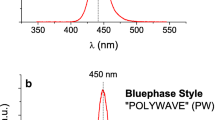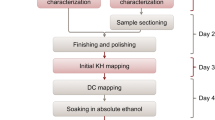Abstract
Objectives
To evaluate light transmittance as a function of wavelength for eight composite materials and compare the transmittance for blue light produced from two curing units with different emission spectra.
Materials and methods
Light transmittance through 2- and 4-mm-thick composite specimens was recorded in real time during 30 s of curing using a broad-spectrum (peaks at 405 and 450 nm) and a narrow-spectrum (peak at 441 nm) LED-curing unit. The spectral resolution of 0.25 nm and temporal resolution of 0.05 s resulted in a large amount of light transmittance data, which was averaged over particular spectral ranges, for the whole measurement period. Statistical analysis was performed using Welch ANOVA with Games-Howell post hoc test, t test, and Pearson correlation analysis. The level of significance was 0.05 and n = 5 specimens per experimental group were prepared.
Results
Light transmittance varied as a function of wavelength and time, revealing significantly different patterns among the tested materials. Light transmittance for different parts of curing unit spectra increased in the following order of emission peaks (nm): 405 < 441 < 450. Of particular interest was the difference in transmittance between 441 and 450 nm, as these peaks are relevant for the photoactivation of camphorquinone-containing composites. A high variability in light transmittance among materials was identified, ranging from statistically similar values for both peaks up to a fourfold higher transmittance for the peak at 450 nm.
Conclusion
Each material showed a unique pattern of wavelength-dependent light transmittance, leading to highly material-dependent differences in blue light transmittance between two curing units.
Clinical relevance
Minor differences in blue light emission of contemporary narrow-peak curing units may have a significant effect on the amount of light which reaches the composite layer bottom.






Similar content being viewed by others
References
Price RB, Ferracane JL, Shortall AC (2015) Light-curing units: a review of what we need to know. J Dent Res 94(9):1179–1186. https://doi.org/10.1177/0022034515594786
Santini A, Miletic V, Swift MD, Bradley M (2012) Degree of conversion and microhardness of TPO-containing resin-based composites cured by polywave and monowave LED units. J Dent 40(7):577–584. https://doi.org/10.1016/j.jdent.2012.03.007
Price RB, Labrie D, Rueggeberg FA, Sullivan B, Kostylev I, Fahey J (2014) Correlation between the beam profile from a curing light and the microhardness of four resins. Dent Mater 30(12):1345–1357. https://doi.org/10.1016/j.dental.2014.10.001
Park SH, Roulet JF, Heintze SD (2010) Parameters influencing increase in pulp chamber temperature with light-curing devices: curing lights and pulpal flow rates. Oper Dent 35(3):353–361. https://doi.org/10.2341/09-234-L
Ernst CP, Price RB, Callaway A, Masek A, Schwarm H, Rullmann I, Willershausen B, Ehlers V (2018) Visible light curing devices - irradiance and use in 302 German dental offices. J Adhes Dent 20(1):41–55. https://doi.org/10.3290/j.jad.a39881
Price RB, Shortall AC, Palin WM (2014) Contemporary issues in light curing. Oper Dent 39(1):4–14. https://doi.org/10.2341/13-067-LIT
Palin WM, Leprince JG, Hadis MA (2018) Shining a light on high volume photocurable materials. Dent Mater 34(5):695–710. https://doi.org/10.1016/j.dental.2018.02.009
Shimokawa C, Sullivan B, Turbino ML, Soares CJ, Price RB (2017) Influence of emission spectrum and irradiance on light curing of resin-based composites. Oper Dent 42(5):537–547. https://doi.org/10.2341/16-349-L
Miletic V, Pongprueksa P, De Munck J, Brooks NR, Van Meerbeek B (2017) Curing characteristics of flowable and sculptable bulk-fill composites. Clin Oral Investig 21(4):1201–1212. https://doi.org/10.1007/s00784-016-1894-0
Emami N, Sjodahl M, Soderholm KJ (2005) How filler properties, filler fraction, sample thickness and light source affect light attenuation in particulate filled resin composites. Dent Mater 21(8):721–730. https://doi.org/10.1016/j.dental.2005.01.002
Musanje L, Darvell BW (2006) Curing-light attenuation in filled-resin restorative materials. Dent Mater 22(9):804–817. https://doi.org/10.1016/j.dental.2005.11.009
Par M, Repusic I, Skenderovic H, Sever EK, Marovic D, Tarle Z (2018) Real-time light transmittance monitoring for determining polymerization completeness of conventional and bulk fill dental composites. Oper Dent 43(1):E19–E31. https://doi.org/10.2341/17-041-L
Ilie N (2017) Impact of light transmittance mode on polymerisation kinetics in bulk-fill resin-based composites. J Dent 63:51–59. https://doi.org/10.1016/j.jdent.2017.05.017
Harlow JE, Rueggeberg FA, Labrie D, Sullivan B, Price RB (2016) Transmission of violet and blue light through conventional (layered) and bulk cured resin-based composites. J Dent 53:44–50. https://doi.org/10.1016/j.jdent.2016.06.007
Harlow JE, Sullivan B, Shortall AC, Labrie D, Price RB (2016) Characterizing the output settings of dental curing lights. J Dent 44:20–26. https://doi.org/10.1016/j.jdent.2015.10.019
Rueggeberg FA, Giannini M, Arrais CAG, Price RBT (2017) Light curing in dentistry and clinical implications: a literature review. Braz Oral Res 31(suppl 1):e61. https://doi.org/10.1590/1807-3107BOR-2017.vol31.0061
Sim JS, Seol HJ, Park JK, Garcia-Godoy F, Kim HI, Kwon YH (2012) Interaction of LED light with coinitiator-containing composite resins: effect of dual peaks. J Dent 40(10):836–842. https://doi.org/10.1016/j.jdent.2012.06.008
Par M, Marovic D, Skenderovic H, Gamulin O, Klaric E, Tarle Z (2017) Light transmittance and polymerization kinetics of amorphous calcium phosphate composites. Clin Oral Investig 21(4):1173–1182. https://doi.org/10.1007/s00784-016-1880-6
Palin WM, Senyilmaz DP, Marquis PM, Shortall AC (2008) Cure width potential for MOD resin composite molar restorations. Dent Mater 24(8):1083–1094. https://doi.org/10.1016/j.dental.2008.01.001
Moszner N, Fischer UK, Ganster B, Liska R, Rheinberger V (2008) Benzoyl germanium derivatives as novel visible light photoinitiators for dental materials. Dent Mater 24(7):901–907. https://doi.org/10.1016/j.dental.2007.11.004
Ilie N, Bucuta S, Draenert M (2013) Bulk-fill resin-based composites: an in vitro assessment of their mechanical performance. Oper Dent 38(6):618–625. https://doi.org/10.2341/12-395-L
Clewell DH (1941) Scattering of light by pigment particles. J Opt Soc Am 31(8):521–527
Campbell PM, Johnston WM, O’Brien WJ (1986) Light scattering and gloss of an experimental quartz-filled composite. J Dent Res 65(6):892–894
Par M, Gamulin O, Marovic D, Klaric E, Tarle Z (2015) Raman spectroscopic assessment of degree of conversion of bulk-fill resin composites--changes at 24 hours post cure. Oper Dent 40(3):E92–E101. https://doi.org/10.2341/14-091-L
Alshali RZ, Salim NA, Satterthwaite JD, Silikas N (2015) Post-irradiation hardness development, chemical softening, and thermal stability of bulk-fill and conventional resin-composites. J Dent 43(2):209–218. https://doi.org/10.1016/j.jdent.2014.12.004
Jakubiak J, Allonas X, Fouassier JP, Sionkowska A, Andrzejewska E, Linden LÅ, Rabek JF (2003) Camphorquinone–amines photoinitating systems for the initiation of free radical polymerization. Polymer 44(18):5219–5226. https://doi.org/10.1016/s0032-3861(03)00568-8
Leprince JG, Palin WM, Hadis MA, Devaux J, Leloup G (2013) Progress in dimethacrylate-based dental composite technology and curing efficiency. Dent Mater 29(2):139–156. https://doi.org/10.1016/j.dental.2012.11.005
Neumann MG, Schmitt CC, Ferreira GC, Corrêa IC (2006) The initiating radical yields and the efficiency of polymerization for various dental photoinitiators excited by different light curing units. Dent Mater 22(6):576–584
Price RB, Felix CA (2009) Effect of delivering light in specific narrow bandwidths from 394 to 515nm on the micro-hardness of resin composites. Dent Mater 25(7):899–908. https://doi.org/10.1016/j.dental.2009.01.098
Arikawa H, Fujii K, Kanie T, Inoue K (1998) Light transmittance characteristics of light-cured composite resins. Dent Mater 14(6):405–411
Neumann MG, Miranda WG Jr, Schmitt CC, Rueggeberg FA, Correa IC (2005) Molar extinction coefficients and the photon absorption efficiency of dental photoinitiators and light curing units. J Dent 33(6):525–532. https://doi.org/10.1016/j.jdent.2004.11.013
Gomes M, DeVito-Moraes A, Francci C, Moraes R, Pereira T, Froes-Salgado N, Yamazaki L, Silva L, Zezell D (2013) Temperature increase at the light guide tip of 15 contemporary LED units and thermal variation at the pulpal floor of cavities: an infrared thermographic analysis. Oper Dent 38(3):324–333. https://doi.org/10.2341/12-060-L
Author information
Authors and Affiliations
Corresponding author
Ethics declarations
Conflict of interest
The authors declare that they have no conflict of interest.
Ethical approval
This article does not contain any studies with human participants or animals performed by any of the authors.
Informed consent
For this type of study, formal consent is not required.
Additional information
Publisher’s note
Springer Nature remains neutral with regard to jurisdictional claims in published maps and institutional affiliations.
Rights and permissions
About this article
Cite this article
Par, M., Repusic, I., Skenderovic, H. et al. Wavelength-dependent light transmittance in resin composites: practical implications for curing units with different emission spectra. Clin Oral Invest 23, 4399–4409 (2019). https://doi.org/10.1007/s00784-019-02896-y
Received:
Accepted:
Published:
Issue Date:
DOI: https://doi.org/10.1007/s00784-019-02896-y




